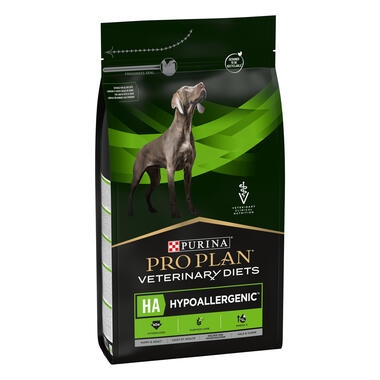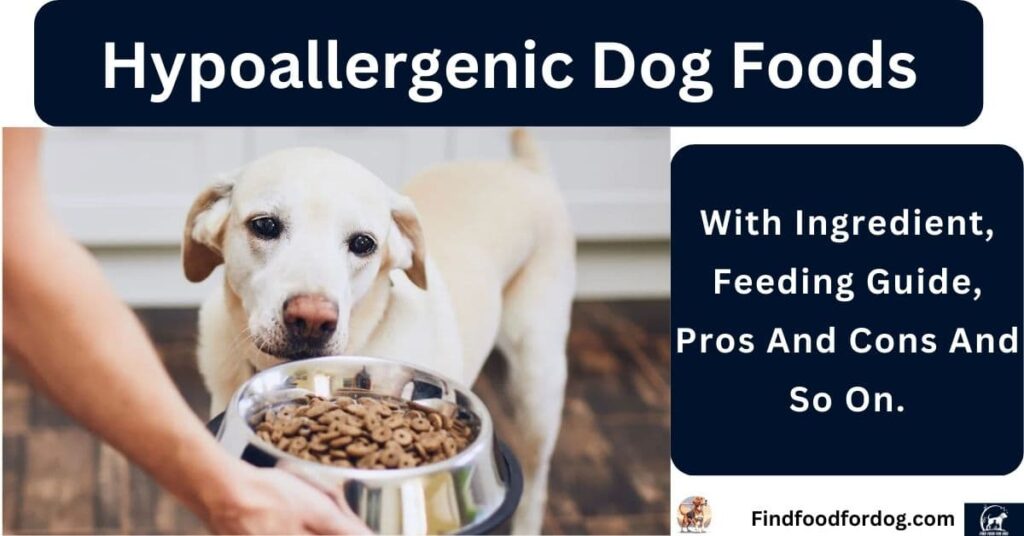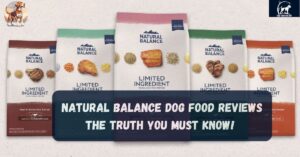Dry hypoallergenic dog food is specially formulated to minimize allergic reactions in dogs. It often contains limited ingredients and novel protein sources.
Choosing the right dog food is crucial for your pet's health, especially if they have allergies. Dry hypoallergenic dog food offers a solution for dogs sensitive to common ingredients like grains or certain proteins. These diets feature limited ingredients to reduce the risk of allergic reactions.
Many brands use unique protein sources, such as lamb or fish, which can help prevent skin irritations and digestive issues. Selecting the right hypoallergenic food can improve your dog's overall well-being and vitality. Understanding your dog's dietary needs can lead to happier and healthier lives for both you and your furry companion.
Introduction To Hypoallergenic Dog Food
Hypoallergenic dog food is designed for dogs with food sensitivities. These diets help reduce allergic reactions. They use limited ingredients to minimize triggers. Many pet owners choose these foods for their furry friends.
Identifying Food Sensitivities In Dogs
Recognizing food sensitivities in dogs is essential. Look for these common signs:
- Itchy skin or hot spots
- Frequent ear infections
- Digestive issues like diarrhea
- Vomiting after meals
- Excessive gas
Keep track of your dog's symptoms. Consult your vet for a proper diagnosis. A food trial may be necessary to identify specific allergens.
Benefits Of Hypoallergenic Diets
Hypoallergenic diets offer several advantages:
| Benefit | Description |
|---|---|
| Reduced Allergies | Less itching and discomfort for your dog. |
| Improved Digestion | Fewer digestive problems lead to better health. |
| Better Skin Health | Healthier skin reduces hot spots and infections. |
| Increased Energy | Balanced nutrition boosts your dog's energy levels. |
These diets can transform your dog's health. Many owners report happier, healthier pets.

Royal Canin
Key Ingredients In Hypoallergenic Dog Food
Understanding the key ingredients in hypoallergenic dog food is essential. These ingredients help manage allergies and sensitivities. They provide balanced nutrition without common allergens.
Novel Proteins Explained
Novel proteins are unique sources of protein. They differ from common proteins like beef or chicken. Here are some examples:
- Duck
- Venison
- Fish
- Rabbit
These proteins reduce the chance of allergic reactions. Dogs with food allergies often benefit from these alternatives. They support healthy muscle and skin.
The Role Of Carbohydrates
Carbohydrates provide energy for active dogs. They also aid in digestion. Look for simple carbohydrate sources like:
- Sweet potatoes
- Peas
- Brown rice
These ingredients are gentle on the stomach. They help maintain a healthy weight. Avoid grains that often cause allergies, like wheat and corn.
Additives And Preservatives To Avoid
Some additives and preservatives can harm your dog. Avoid these ingredients:
- Artificial colors
- Flavor enhancers
- Preservatives like BHA or BHT
Choose dog food with natural preservatives. Look for ingredients like:
- Tocopherols (Vitamin E)
- Rosemary extract
These options keep the food fresh without harmful effects.
Top Rated Hypoallergenic Dog Food Brands
Choosing the right hypoallergenic dog food is essential for your pet's health. Many dogs suffer from food allergies. Hypoallergenic diets can help reduce allergy symptoms. Here are some top-rated brands to consider.
Royal Canin Review
Royal Canin offers a great selection of hypoallergenic dog food. Their recipes focus on high-quality proteins. They use limited ingredients to avoid allergens.
- Key Ingredients: Salmon, sweet potatoes, and peas.
- Benefits: Grain-free, easily digestible, and rich in omega fatty acids.
This brand is highly recommended by veterinarians. Many pet owners report improved skin and coat health.
Hill's Science Diet Highlights
Hill's Science Diet is known for its unique formulations. They use novel proteins that dogs may not have tried before. This helps reduce allergic reactions.
- Unique Protein Sources: Kangaroo, duck, and venison.
- Features: Grain-free, no artificial additives, and high in fiber.
Many customers love the taste. Dogs enjoy the flavors, making mealtime exciting.
Purina Pro Plan Features
Purina Pro Plan focuses on natural ingredients. Their recipes include wholesome fruits and vegetables. This brand aims to provide a balanced diet.
- Main Ingredients: Chicken, brown rice, and carrots.
- Benefits: Rich in antioxidants, supports immune health.
Brand C is suitable for all life stages. It helps maintain a healthy weight and supports energy levels.
| Brand | Main Protein | Special Features |
|---|---|---|
| Royal Canin | Salmon | Grain-free, omega fatty acids |
| Hill's Science Diet | Kangaroo | Novel protein, high fiber |
Purina Pro Plan | Chicken | Natural ingredients, antioxidants |
Royal Canin
Hill's Science Diet
Purina Pro Plan

Hill's Science Diet
Grain-free Options For Dogs
Grain-free dog food is a popular choice for many pet owners. It eliminates common grains like wheat, corn, and soy. Many believe it benefits dogs with food sensitivities. Grain-free diets can also provide alternative protein sources.
Pros And Cons Of Grain-free Diets
Understanding the benefits and drawbacks of grain-free diets is essential. Here’s a quick overview:
| Pros | Cons |
|---|---|
| May reduce allergies | Can be more expensive |
| Improves digestion | Some dogs may lack nutrients |
| Higher protein content | Not suitable for all dogs |
| Better energy levels | Possible heart issues with some brands |
Recommended Grain-free Brands
Choosing the right grain-free dog food is vital for your pet's health. Here are some highly recommended brands:
- Orijen – High protein and fresh ingredients.
- Acana – Quality meat sources and balanced nutrition.
- Blue Buffalo Wilderness – Grain-free with added vitamins.
- Wellness CORE – Focuses on high protein and low carbs.
- Taste of the Wild – Offers unique protein sources.
Always consult with your vet. They can help you choose the best option for your dog's needs.
Homemade Hypoallergenic Meals
Creating homemade hypoallergenic meals for dogs can be rewarding. You control the ingredients, ensuring they suit your dog's needs. This option is great for dogs with food allergies or sensitivities. Let’s explore some easy recipes that can help your furry friend thrive.
Homemade Dog Food
Recipes For Sensitive Dogs
Here are some simple recipes for sensitive dogs. Each recipe uses limited ingredients that are easy to digest.
- Chicken and Rice:
- 1 cup of cooked chicken (shredded)
- 1 cup of cooked white rice
- 1/2 cup of carrots (steamed and chopped)
- Beef and Sweet Potato:
- 1 cup of ground beef (lean)
- 1 cup of sweet potato (mashed)
- 1/2 cup of peas (cooked)
- Fish and Quinoa:
- 1 cup of cooked fish (like salmon)
- 1 cup of cooked quinoa
- 1/2 cup of green beans (steamed)
Balancing A Homemade Diet
Balancing a homemade diet is crucial for your dog's health. Follow these tips to create a nutritious meal plan.
- Include protein sources like chicken, beef, or fish.
- Add carbohydrates such as rice, potatoes, or quinoa.
- Incorporate vegetables for vitamins and minerals.
- Consult your vet for vitamin and mineral supplements.
Use a variety of ingredients to keep meals interesting. Monitor your dog for any signs of allergies. Adjust recipes based on their reactions. Homemade meals can provide your dog with the best nutrition!
Transitioning To Hypoallergenic Food
Changing your dog's diet to dry hypoallergenic dog food can improve their health. It helps manage allergies and sensitivities. A smooth transition is crucial. A sudden change may upset your dog's stomach. Follow a structured approach for the best results.
Steps For A Smooth Transition
- Start Slowly: Begin by mixing a small amount of hypoallergenic food with the current food.
- Gradually Increase: Over 7 to 10 days, slowly increase the hypoallergenic food ratio.
- Monitor Portions: Ensure the overall portion remains the same during the transition.
- Stay Consistent: Stick to a regular feeding schedule to avoid confusion.
- Watch for Changes: Observe your dog for any signs of discomfort or allergy symptoms.
Monitoring Your Dog's Response
Keep a close eye on your dog's health throughout the transition. Look for any positive or negative reactions. Important signs to monitor include:
- Changes in appetite
- Digestive issues like vomiting or diarrhea
- Skin irritations or itching
- Overall energy levels
Document these changes. This record helps you understand how your dog reacts to the new food. Share this information with your vet for better guidance.
Veterinary Insights On Allergy Management
Managing dog food allergies requires expert guidance. Veterinarians provide essential insights. Their knowledge helps owners choose the right hypoallergenic dog food.
Expert Advice On Food Allergies
Veterinarians recommend a few key steps for managing food allergies:
- Understand the signs of food allergies.
- Choose a high-quality hypoallergenic dog food.
- Monitor your dog's health regularly.
Common signs of food allergies include:
- Itchy skin or ears
- Frequent ear infections
- Stomach upset or diarrhea
Consult your vet for tailored recommendations. Regular check-ups keep your dog healthy.
Testing For Allergens
Identifying allergens is crucial for effective management. Here are some common testing methods:
| Testing Method | Description |
|---|---|
| Elimination Diet | Avoid specific ingredients to identify triggers. |
| Blood Tests | Measure allergen-specific antibodies in the blood. |
| Skin Tests | Check for reactions to common allergens. |
Take advice from Pet Expert Dr Marty
ESA Pet is an online service that helps you get a legitimate ESA letter
Pet vitamin supplements and grooming products
Work closely with your veterinarian. They will recommend the best tests for your dog. Accurate testing leads to a proper diet.
Customer Reviews And Testimonials
Customer feedback plays a vital role in choosing the right dry hypoallergenic dog food. Many pet owners share their experiences online. These stories often highlight how specific brands have helped their sensitive pets thrive. Let's dive into some real-life success stories and compare user experiences.
Success Stories Of Sensitive Pets
Many pet owners have seen remarkable changes in their dogs. Here are a few success stories:
- Max the Beagle: After switching to hypoallergenic food, Max's skin issues improved significantly. His owner noted a decrease in itching and scratching.
- Luna the Golden Retriever: Luna had digestive problems. The new diet helped her enjoy her meals without discomfort.
- Buddy the Poodle: Buddy was often lethargic. After the diet change, he became more energetic and playful.
These stories show the positive impact of hypoallergenic diets. Owners report happier, healthier pets. A balanced diet can transform your dog's life.
Comparing User Experiences
| Brand | Pet's Condition | Owner's Feedback |
|---|---|---|
| Brand A | Skin Allergies | Great improvement in skin health! |
| Brand B | Digestive Issues | Less vomiting and diarrhea. |
| Brand C | Low Energy | Pet is more active and playful! |
Users report varied experiences with different brands. Some dogs thrive on specific formulas, while others may need a different option. Always consider your pet's unique needs. Read reviews to guide your choice.
These testimonials highlight the importance of finding the right hypoallergenic food. Your dog's health and happiness depend on it.
Additional Care For Allergy-prone Dogs
Taking care of allergy-prone dogs requires special attention. These dogs need more than just hypoallergenic food. Proper skin and coat care are crucial. Understanding environmental allergens can help too.
Skin And Coat Care
Healthy skin and coat are vital for dogs with allergies. Regular grooming helps remove dirt and allergens. Use hypoallergenic shampoos to avoid irritation. Here are some tips:
- Brush your dog's coat weekly.
- Choose gentle, fragrance-free shampoos.
- Bathtub baths should be limited to avoid dryness.
- Use moisturizing sprays for extra hydration.
Watch for signs of skin irritation:
- Red or inflamed skin
- Excessive scratching
- Hot spots or scabs
Consult a vet if you notice any of these signs. They can recommend the best treatments.
Environmental Allergens And Your Dog
Environmental allergens can trigger reactions in sensitive dogs. Common allergens include:
| Allergen | Source |
|---|---|
| Pollen | Grass, trees, and weeds |
| Mold | Wet areas, leaves, and soil |
| Dust mites | Home dust and bedding |
| Fleas | Outdoor areas and other pets |
To reduce exposure:
- Keep your home clean and dust-free.
- Wash your dog’s bedding regularly.
- Avoid walks during high pollen times.
- Use flea prevention treatments.
Being proactive helps keep your dog comfortable and healthy. Regular vet check-ups are essential for monitoring allergies.
Cost Analysis Of Hypoallergenic Dog Food
Understanding the cost of hypoallergenic dog food is essential for pet owners. These specialized diets can vary significantly in price compared to regular dog food. This section breaks down the costs, helping you make informed choices for your furry friend.
Price Comparison With Regular Dog Food
Hypoallergenic dog food generally costs more than regular dog food. Here’s a quick comparison:
| Type of Dog Food | Average Price per 30 lbs |
|---|---|
| Regular Dog Food | $30 – $50 |
| Hypoallergenic Dog Food | $50 – $100 |
Prices vary based on brand and ingredients. Premium hypoallergenic foods cost more due to high-quality ingredients.
Budgeting For Your Dog's Diet
Budgeting is crucial for maintaining your dog's diet. Here are some tips:
- Determine Monthly Costs: Calculate how much you spend each month.
- Look for Sales: Check for discounts or promotions.
- Buy in Bulk: Purchasing larger quantities can save money.
- Consider Homemade Options: Consult with a vet for balanced recipes.
Keep track of your spending. Here’s a simple budgeting method:
- Calculate your dog’s daily food needs.
- Multiply by the number of days in a month.
- Factor in any treats or supplements.
- Set aside a specific budget each month.
Investing in your dog’s health is important. A proper diet helps avoid costly vet bills later.

Purina Pro Plan
Frequently Asked Questions About Dry Hypoallergenic Dog Food
What Is Dry Hypoallergenic Dog Food?
Dry hypoallergenic dog food is specially formulated to reduce allergic reactions in dogs. It contains limited ingredients, often featuring novel proteins and carbohydrates. This type of food helps alleviate symptoms like itching and digestive issues, making it suitable for dogs with food sensitivities.
How Does Hypoallergenic Food Benefit Dogs?
Hypoallergenic food benefits dogs by minimizing allergic reactions to common ingredients. It uses unique proteins and grains that dogs may not have previously encountered. This can lead to improved skin health, better digestion, and an overall happier pet. Dogs with allergies often thrive on these specialized diets.
Can All Dogs Eat Hypoallergenic Food?
Not all dogs need hypoallergenic food, but it is beneficial for those with allergies or sensitivities. Consult your veterinarian for personalized advice. They can help determine if your dog requires a hypoallergenic diet based on their specific health needs and symptoms.
How To Choose The Right Hypoallergenic Dog Food?
Choosing the right hypoallergenic dog food involves checking ingredient lists carefully. Look for products with limited ingredients and no common allergens like wheat or corn. Always consult your vet for recommendations based on your dog's specific allergies, age, and health conditions to ensure optimal nutrition.
Conclusion
Choosing dry hypoallergenic dog food can greatly benefit dogs with sensitivities. It helps in managing allergies and promotes overall health. Opt for high-quality brands that focus on natural ingredients. Your dog deserves the best nutrition. Make informed choices to ensure their well-being and happiness.
Happy feeding




















